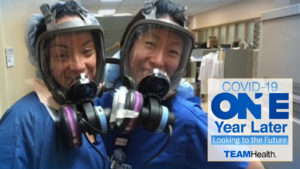Anesthesia team constantly adapted to handle surge at COVID-19 epicenter in New York
NewYork-Presbyterian Hospital Queens was one of the first facilities in New York to face the surge of COVID-19 cases in the spring of 2020, but the week of March 16 marked the onslaught of what would make them the epicenter of the pandemic. In a few short weeks, they would handle a patient load well over their standard capacity turning the entire hospital into a COVID-19 treatment facility.
Ahmed Soliman, MD, MBA, Chairman of the department of Anesthesiology, TeamHealth Facility Medical Director recalls, “We tried to maintain the operating rooms, but soon after that completely stopped all procedures. We changed call schedules to maintain full and adequate continuous coverage. We formed intubation teams, line teams, and ICU coverage.”
They quickly learned that flexibility and adaptability were critical to responding to the rapidly evolving crisis and everyone at the facility was willing to do their part. At that point, the anesthesia team became the airways team handling every airway across the entire hospital. “We were called day and night from every floor and section at the hospital. All intubations were performed by the anesthesia team. We also had anesthesiologists and nurse anesthetists deployed to the ICU to help the critical care clinicians in every way possible,” says Dr. Soliman. COVID was a completely new disease, so initial information about it was very primitive. They continually tracked what worked to improve patient outcomes; positive trends were noted and treatment protocols were updated frequently.
After a year of continual innovation and education regarding treatment protocols, Dr. Soliman says they are finally seeing the light at the end of the tunnel. “We still have a high number of COVID patients at the hospital, but not to the level that is overwhelming the system,” he shares. Increased vaccine distribution is also helping to ease the stress of the pandemic for clinicians at the facility. “The number of vaccinated people is growing weekly and with that we hope to see a decrease in hospitalizations and the overall mortality rate,” he states optimistically. Dr. Soliman hopes the virus can eventually be treated with annual vaccinations just like the seasonal flu.
Throughout it all he is proud of his team and how they came together to handle the unimaginable, “The pandemic showed the character of our people. Everyone stepped up, cared for each other, and did what we do best which is take care of the sick.” He is hopeful better days are ahead and that we all have learned one important lesson from this crisis, “I believe this pandemic has changed our lives, and the way we live our days. It has opened our eyes and hearts to what we need to prioritize.”
